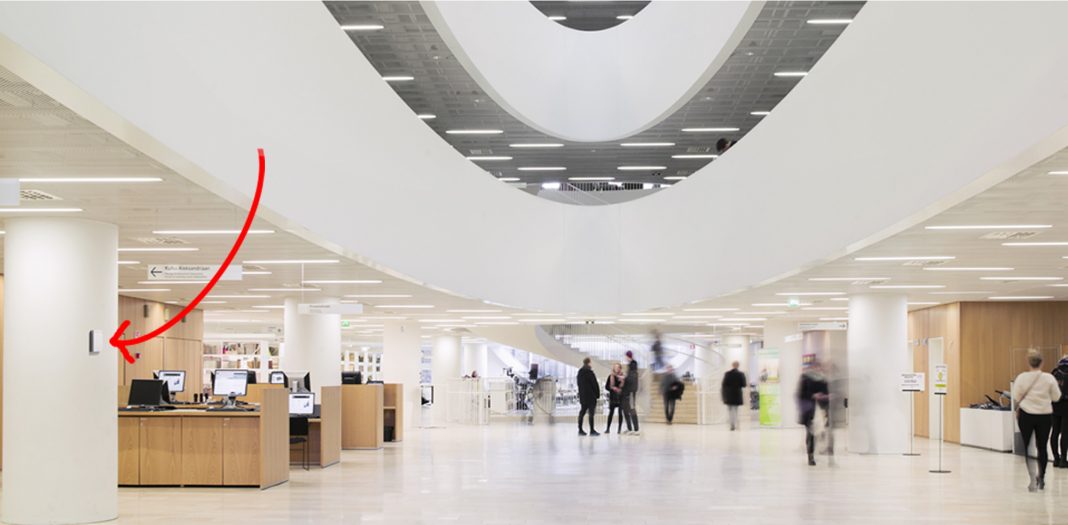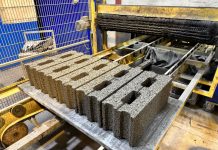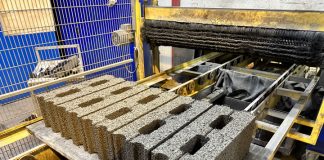As countries emerge from the pandemic, it will be interesting to see what the ‘new normal’ looks like. Will workers return to their offices full time? Or will there be a new preference for more flexible hours and for hybrid working (home + office). Either way, there will be a new, heightened responsibility for employers and facilities managers to account for microbiological hazards such as Covid-19 in the provision of safe indoor environments.
In the following article Anu Katka, an indoor environment specialist from Vaisala (Finland), examines the role that ventilation systems will play in protecting workers from future microbiological threats. She also explains why the reliable measurement of carbon dioxide will be critically important because it is the best measure of effective ventilation.
Lessons from COVID-19
COVID-19 is caused by the SARS-CoV-2 virus, which is transmitted in two ways by infected people. Firstly, viruses can survive on surfaces for up to several weeks1, especially at cooler room temperatures2. Consequently, fomite transmission is possible when people touch infected surfaces and transfer the virus to their mouth, nose or eyes. Secondly, the virus can spread from an infected person’s mouth or nose in small liquid particles when they cough, sneeze, speak or breathe. These liquid particles vary from larger respiratory droplets to smaller aerosols of less than 5µm diameter.
According to the World Health Organisation3 (WHO): Aerosol transmission can occur in specific settings, particularly in indoor, crowded and inadequately ventilated spaces, where infected person(s) spend long periods of time with others, such as restaurants, fitness classes, nightclubs, offices and/or places of worship.
By understanding the modes of transmission, governments have been able to define appropriate strategies to combat viral transmission with measures such as facemasks, social distancing, hand washing and surface disinfection. Importantly, governments have also recognised the increased threat from indoor environments, with recommendations for outdoor activity and increased ventilation.
In November 2020, the UK Government published a video4 highlighting the importance of ventilation in reducing the spread of Covid-19. Their report said: “Research shows that being in a room with fresh air can reduce the risk of infection from particles by over 70%”
In January 2021 hundreds of Canadian experts (physicians, scientists, occupational health and safety experts, engineers and nursing professionals) wrote an open letter5 to their Prime Minister urging him to: “to update provincial COVID-19 guidelines, workplace regulations and public communication to reflect the science — COVID-19 spreads through inhaled aerosols.” One of the key recommendations in the letter was to: “Recommend and deploy carbon dioxide (CO2) monitors as a surrogate measure in case of inadequate ventilation to reduce long-range transmission risk in shared room air. During a TB outbreak, CO2 concentrations above 1000 PPM significantly increased the risk of becoming infected with TB. Improving the building ventilation to a CO2 concentration of 600 PPM stopped the outbreak in its tracks.”
The significance of particle size
The WHO says that infected people appear to be most infectious just before they develop symptoms. In addition, some infected people are asymptomatic, so it is logical to assume that in an office environment, the main threat will NOT come from people with severe symptoms such as coughing and sneezing, but from those who do not realise that they have the disease. These people are more likely to exhale viral aerosols of less than 5µm diameter – particles which do not respect social distancing. These fine aerosols are roughly equivalent in size to the particles in cigarette smoke, which, as we know, do not settle readily and are able to spread widely in poorly ventilated spaces.
A recent paper published in The Lancet6 described studies of cough aerosols and exhaled breath from patients with various respiratory infections which showed striking similarities in aerosol size distributions, with a predominance of pathogens in small particles (<5 μm). These particles are immediately respirable and can remain airborne indefinitely under most indoor conditions – unless there is removal by air currents or dilution ventilation.
Humidity also affects the spread of aerosols because low levels of humidity cause aerosols to become lighter and therefore better able to remain airborne. Humidity has also been shown to affect vulnerability to viral infection7 because exposure to dry air impairs host defense against influenza infection, reduces tissue repair, and inflicts cell breakdown.
Risk reduction measures
Traditional health and safety risk assessments address hazards such as slips and trips, heavy objects, repetitive injury, falling, stress, electric shock, fire and lone working, but to create Covid-secure environments, organisations will need to also include an assessment of microbiological risk. It will therefore be necessary to identify potential sources of pathogenic microorganisms as well as their modes and paths of transmission.
Hand sanitizer can be made available and surfaces can be frequently disinfected. Procedures can be established to reduce the chance of disease transmission, with measures such as screens, social distancing and even disinfectant fogging. However, even with all of these measures in place, one infected person can quickly contaminate large areas. Effective ventilation will therefore be essential, and the control system will need to undertake accurate and timely measurements from each room or space so that it can respond promptly. Some systems may simply monitor CO2 in the exhaust gas, but this does not provide the ability to detect poor ventilation issues in specific spaces.
Choosing the best measurement parameter
One of the main functions of a building automation/management system (BMS) is to control thermal comfort and optimize energy usage, so temperature is undeniably the most important control parameter in occupied spaces. Some systems also measure and control humidity to maintain a level of 40-60% RH. This is for health and comfort reasons as well as the protection of computer systems and the avoidance of structural or mould-related issues in the building.
Temperature measurements do not generally suffer from drift, but traditional humidity sensors do, so Vaisala’s HUMICAP ® sensors are preferable because of their long-term stability and insensitivity to interferences such as dust and condensation. These thin-film capacitive humidity sensors have become the industry standard in a wide variety of applications where long-term accurate, reliable, maintenance-free humidity measurements are required.
Increased humidity levels can be an indication of human activity and poor ventilation. However, humidity varies considerably as a result of external factors (e.g. freezing dry conditions or rainy humid conditions) rather than as a result of human exhalation.
To summarize, temperature and humidity monitoring play an important role in the optimization of a BMS, but where facility managers need to take into account the occupancy of people and reduce human-generated pollution in spaces, CO2 is the ideal additional parameter for automatic ventilation control.
Using Carbon Dioxide measurement as a proxy for effective ventilation
Carbon Dioxide (CO2) is exhaled by people as they breathe, so an accumulation of CO2 indicates that (a) people are in the room and (b) the ventilation is insufficient, so a good ventilation system should be able to detect this and automatically apply the correct amount of ventilation. Obviously people cannot be relied upon to manually control ventilation, windows or vents effectively. The system must be automatic, and it must be able to ventilate individual spaces, so that each space is ventilated optimally and energy is not wasted over-ventilating or ventilating spaces that do not need it.
Non-Covid advantages of CO2 and humidity monitoring
The ASHRAE Green Standard 189.1(USA) and the European standard FprEN 16798-3 recommend using demand controlled ventilation (DCV) to reduce energy usage while promoting healthy indoor air.
From an HVAC design perspective, CO2 is an ideal proxy for indoor air quality where the building is predominantly occupied by people. Humidity would be either better or at least a useful additional parameter, especially in buildings that are used to store artwork, books, wine, historic artefacts etc., or in buildings that are themselves in need of conservation.
Typically, outdoor air contains 250 to 400 ppm CO2. In contrast, exhaled breath contains around 50,000ppm CO2 which represents a 100 fold increase over inhaled gas, so without adequate ventilation, CO2 levels will rise.
Both the comfort and performance of people inside buildings can be affected by CO2 levels. Occupied spaces with good air exchange may contain 350-1,000 ppm, but anything above this can induce drowsiness, with levels above 2,000 ppm causing headaches, sleepiness, poor concentration, loss of attention, increased heart rate and slight nausea. Exposure to very high levels (from oil/gas burners or gas leaks) can even result in fatalities from asphyxiation.
Recommended minimum ventilation rates are provided for a wide variety of indoor spaces in ANSI/ASHRAE Standard 62.1-2019 Ventilation for Acceptable Indoor Air Quality.
Several studies have evaluated the effects of CO2 concentration on cognitive function. For example, Allen et al (2016)8 found that cognitive function scores were 15% lower for the moderate CO2 day (~945 ppm) and 50% lower on a day with CO2 concentrations of ~1,400 ppm in comparison with two ‘Green+’ days (~ 540 ppm). On average, a 400-ppm increase in CO2 was associated with a 21% decrease in a typical participant’s cognitive scores. DCV based on CO2 measurements can therefore deliver improvements in well-being and productivity that far outweigh the costs of the DCV system itself.
Choosing the right CO2 sensor
It is important to resist the temptation to purchase the cheapest sensors that meet the required specification. This is because, whilst accuracy and range are important; the ongoing performance of the BMS will rely on the stability of the sensors.
Suppliers of HVAC systems will naturally prefer sensors that you can ‘fit and forget’. Consequently, it is necessary to select sensors that do not require frequent recalibration to prevent drift. However, the selection process is further complicated by sensors that claim to compensate for drift by implementing a software solution which assumes that the lowest measured readings are the same as the average outdoor concentration of CO2. The danger with this type of algorithm is that small errors are compounded as time passes; leading to very significant errors in the longer term. As an attempt to avoid true calibration, these software algorithm sensors are not applicable in spaces that are continuously occupied, and can also be fooled by building automation systems that aggressively ramp down fresh-air intake during off-peak hours. In some cases even the concrete in the walls may absorb CO2 and thereby ‘trick’ the algorithm and create further inaccuracy.
BMS suppliers or installers may not be responsible for the performance of the CO2 sensors following installation, so their natural inclination might be to opt for sensors with a low purchase cost, but from the building owner or facility manager’s perspective, the key metric is not the purchase cost; it is the lifetime cost.
The cost of a good sensor fades into insignificance in comparison with the benefits that it provides. Energy savings from accurate, need-based controls can be considerable, but even more importantly, the health and well-being of people inside of the building are protected and indoor conditions improve workplace performance.
The ideal solution is therefore to opt for Vaisala CARBOCAP® CO2 sensors. This is because they employ dual beam technology and are able to conduct true self-calibration with an internal reference. The cost of this technology is insignificant in comparison with the energy costs of a BMS that is not efficient or with the cost of maintenance when low-cost sensors drift or fail.
It is not uncommon for Vaisala’s sensors to operate trouble-free for up to 15 years. This stability and reliability has been recognised around the world… and beyond. Vaisala sensors continue to operate on NASA’s Curiosity Rover, which was launched in 2011, and on-board the Perseverance Rover which landed on Mars in February 2021.
In summary, all of the best disease prevention measures can be rendered redundant if the exhaled breath from an infected individual is allowed to remain in a work space. Smart, demand controlled ventilation is therefore necessary with real-time monitoring of CO2 so that inadequate ventilation can be prevented.
ENDS
Words: 1,981
References:
- Kampf, G. et al. (2020) Persistence of coronaviruses on inanimate surfaces and their inactivation with biocidal agents. Journal of Hospital Infection.
- Ratnesar-Shumate S, et al. (2020). Simulated sunlight rapidly inactivates SARS-CoV-2 on surfaces. The Journal of Infectious Diseases.
- World Health Organization: https://www.who.int/news-room/q-a-detail/coronavirus-disease-covid-19-how-is-it-transmitted
- gov.uk/government/news/new-film-shows-importance-of-ventilation-to-reduce-spread-of-covid-19#:~:text=Coronavirus%20is%20spread%20through%20the,virus%20transmissions%20happen%20indoors.
- https://ricochet.media/en/3423/there-is-still-time-to-address-aerosol-transmission-of-covid-19
- Fennelly, K.P., (2020). Particle sizes of infectious aerosols: implications for infection control. THE LANCET, Respiratory Medicine, VOLUME 8, ISSUE 9, P914-924.
- E. et al (2019) Low ambient humidity impairs barrier function and innate resistance against influenza infection. Proceedings of the National Academy of Sciences, 116 (22).
- Allen J.G. et al. (2016) Associations of Cognitive Function Scores with Carbon Dioxide, Ventilation, and Volatile Organic Compound Exposures in Office Workers: A Controlled Exposure Study of Green and Conventional Office Environments. Environmental Health Perspectives 124:6 CID: https://doi.org/10.1289/ehp.1510037







